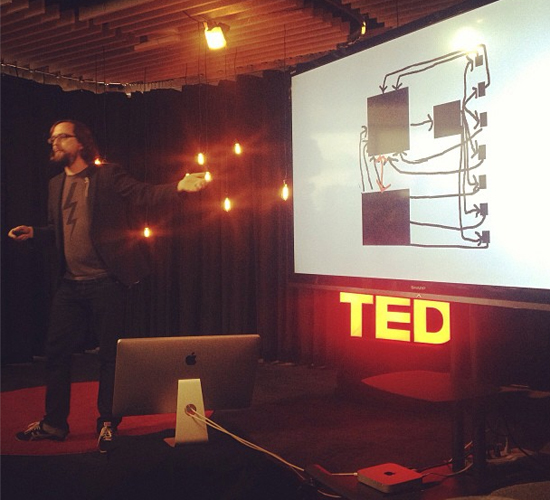
The term “fiscal cliff” has gained traction in the U.S. news in the past few months, at least in part because it paints a vivid metaphorical picture. Popularized by Federal Reserve Chairman Ben Bernanke, the term refers to the ill economic consequences that could occur if Congress does not change its course on several policies by January 1, 2013 — including the expiration of Bush-era tax cuts and automatic spending cuts that were agreed to in 2011. But for Congress to act, Democrats and Republicans need to find some general agreement on how to bridge the gap between the federal government’s revenues and spending. Let’s just say that’s been slow to come.
As the deadline nears, we invited three speakers — social psychologist Jonathan Haidt, data visualizationist Jer Thorp and “Planet Money” co-host Adam Davidson — to our New York office for a TED@250 salon, part of a new program to reimagine the headlines. The idea: to give us a deeper understanding of the issue and why it has been so darn difficult for American political parties to work together in recent times.
First to the stage was Jonathan Haidt, who explored “The moral roots of liberals and conservatives” at TED2008. Haidt began his talk with a dramatic statement: Four asteroids are headed for the United States, and they will hit within 50 years.
These, of course, are allegorical asteroids — climate change that could flood many of our major cities, the federal debt rising to the point where a welfare state may become untenable, a growing rise in inequality which is making us deeply distrustful of each other, and the breakdown of marriage which feeds into disparity in income. The problem, as Haidt explains it, is that the current American political climate makes it very difficult to see all four as true problems.
“In our hyper-politicized time, one person says, ‘Look! An asteroid is coming.’ And the other person won’t even look up,” says Haidt. “Retiring members of Congress say that it’s become like gang warfare.”
In his talk, Haidt looks at the social underpinnings that create this type of polarization, where fingers are pointed while real data is ignored. And he also presents several ideas for what could help relieve these tensions and get politicians working together to solve problems. One of his simplest ideas is to shift Congress’ schedule to three weeks on, one week off. This way, members of Congress will be forced to make homes in Washington, D.C., instead of flying home every week. With more politicians living in the Capitol, they’d socialize and meet each other’s families, allowing them to build common ground where the idea, “Hey, the other guy might have a point,” could surface.
At TEDxVancouver, Jer Thorp urged us to “Make data more human.” Today, he shared a fascinating project, “The Colour Economy,” in which he gave screen pixels a very human ability — to trade their red, green and blue values in pursuit of a profit. As the colored bits moved on a screen, stratifications emerged — a situation which feels all too familiar.
Thorp’s point is that data visualization can help us understand how and why things happen, and can inspire new realizations. Currently, says Thorp (shown above), there are a mishmash of images and metaphors that cloud our understanding of the economy. Could creative uses of data — data fiction, data poetry, data theater — gives us new ways of thinking?
Finally, Adam Davidson spoke, describing the fiscal cliff as “a self-imposed arbitrary deadline,” that both parties need to resolve, though neither wants to make the first move and be seen as weak. In other words, it’s a game of chicken, fueled by partisan anger. “The worse the crisis gets, the more each side thinks they have the answer,” says Davidson.
But what’s so curious, he explains, is that the American population isn’t as polarized as one would think, and people even tend to agree — for the most part — on what kinds of decisions we should make about the federal budget. For example: When asked, people want Social Security and Medicare to stay strong. “The American people tend to be moderate, pragmatic centrists,” says Davidson. “You’d think that if you add up Democrat and Republican, you get the American people, but that’s not what the data shows … Forty percent of people consider themselves independent.”
American history, says Davidson, is full of skirmishes about money. And yet the dollar has remained one of the most stable currencies. So when it comes to the fiscal cliff, he urges, “Instead of talking about it in vague terms that feed partisanship, let’s talk about it as what it really is — a really solvable math problem. Though not one where we’re all going to get what we want.“
After an election that seemed to bring partisanship to a fever pitch, there seemed to be a pulling together this weekend as the nation mourned those killed in the school shooting in Connecticut on December 14. When asked if he thought the same polarization would happen with gun control that has been happening over the economy, Haidt shared enthusiasm that this could be an issue that highlights commonality and brings across-the-divide cooperation. As we arrived back at our desks from the salon, a new headline appeared on NYTimes.com that suggested this may be the case: “Newtown Shooting May Cool Washington’s Partisan Passions.”
Comments (3)
Pingback: Defusing political conflicts: A Q&A with Jonathan Haidt about how liberals and conservatives can band together | Krantenkoppen Tech
Pingback: Adam Davidson on the fiscal cliff, cable TV, $4000 suits, the giant pool of money and more | Krantenkoppen Tech